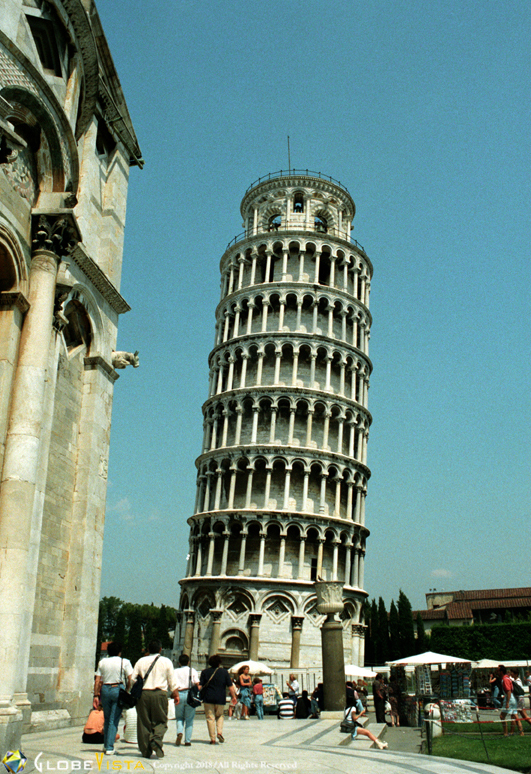The Tower of Pisa is the bell tower of the Cathedral (Duomo) and it was built from white marble. The architect of the tower has always remained a mystery though there are those who believe it to be Bonanno Pisano. Recently it was suggested it could have been Diotisalvi who was the architect of the Baptistry. Construction on the tower began in 1173 AD, and almost right from the beginning, the tower has been an architectural nightmare. Thanks to the soft ground and a shallow foundation, the tower began to lean as early as the time the third floor was completed. This despite the over 13 foot-thick walls at the base. But engineers at the time had few resources to call on. There was no ground-penetrating radar, geological science, lasers or huge cranes to right the work.
 Ironically, the tower is not, or more accurately was not, the main attraction of the site. It was intended as a bell tower for the nearby cathedral. Both are extraordinary works of Romanesque-Gothic art. It’s only because of an unfortunate engineering failure that the tower is the more famous of the two structures.
Ironically, the tower is not, or more accurately was not, the main attraction of the site. It was intended as a bell tower for the nearby cathedral. Both are extraordinary works of Romanesque-Gothic art. It’s only because of an unfortunate engineering failure that the tower is the more famous of the two structures.
But far from being considered a failure at the time, it was not completely unknown for buildings to be less than perfect 800 years ago. There are examples in Germany, Ireland, and even not far away inside Tuscany of both towers and rectangular buildings that lean slightly.
From the base, standing far back from the tower, one can see the round, layer-cake type facade. The base is somewhat plain, but not far up there are magnificent columns. The elaborate carving is even more amazing when one considers that the major construction effort was completed less than 200 years after the beginning.
The project was stalled for about 100 years while the Pisans engaged in battles with Genoa and other Italian city-states of the period. Then, picking up in 1275 AD it stalled again in 1284 AD, just before the belfry was added. Finally, in 1360, the building topped out at 51m/167ft.

There are seven bells in the tower, with the largest bell weighing three and a half tons. Inside the tower is a spiral staircase with 293 steps.
After over a decade of being strapped in steel cables and inaccessible to tourists, La Torre di Pisa is open once again. Nearly $30 million was spent to prevent the tower from leaning any further to avoid total collapse. Now it is good for another 300 years.
From the perspective of distance, those who observe carefully can see that not only is the tower leaning (which is obvious), but that it is curved as well. Noting the lean, builders attempted to compensate by making some of the floors taller on the side opposite. The result gives the tower its slight banana shape.
Fortunately, since digging out 70 tons of earth from below the ground, the tower was reopened in 2001. Visitors in bunches of 30 can now go up inside for a 35-minute guided tour. Be sure to obtain tickets well in advance. It’s a hugely popular attraction.
Now, tourists can see the surrounding area from on high, as well as some of the magnificent bells in the belfry. Not to worry about the lean, though. It’s only 13 feet from vertical and modern engineering has ensured a safe visit.
Trivia About the Leaning Tower of Pisa
More than 250 people have fallen to their deaths since 1174.
Galileo is believed to have performed his experiment with gravity from the tower’s belfry. Rumour has it that he dropped a cannonball and a wooden ball, of the same size, to prove his theory that balls of different weights would both fall at the same rate.
